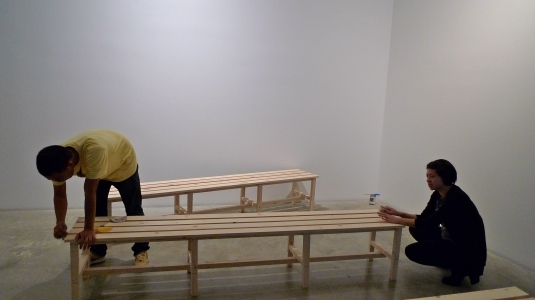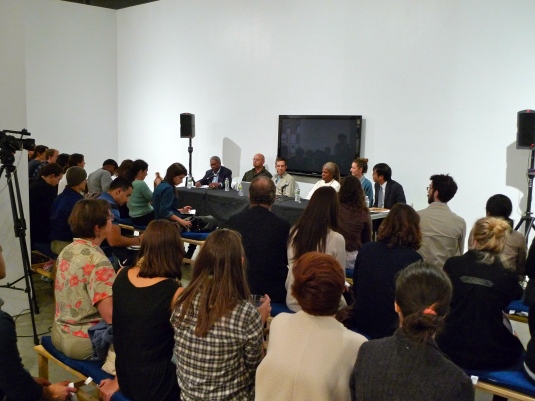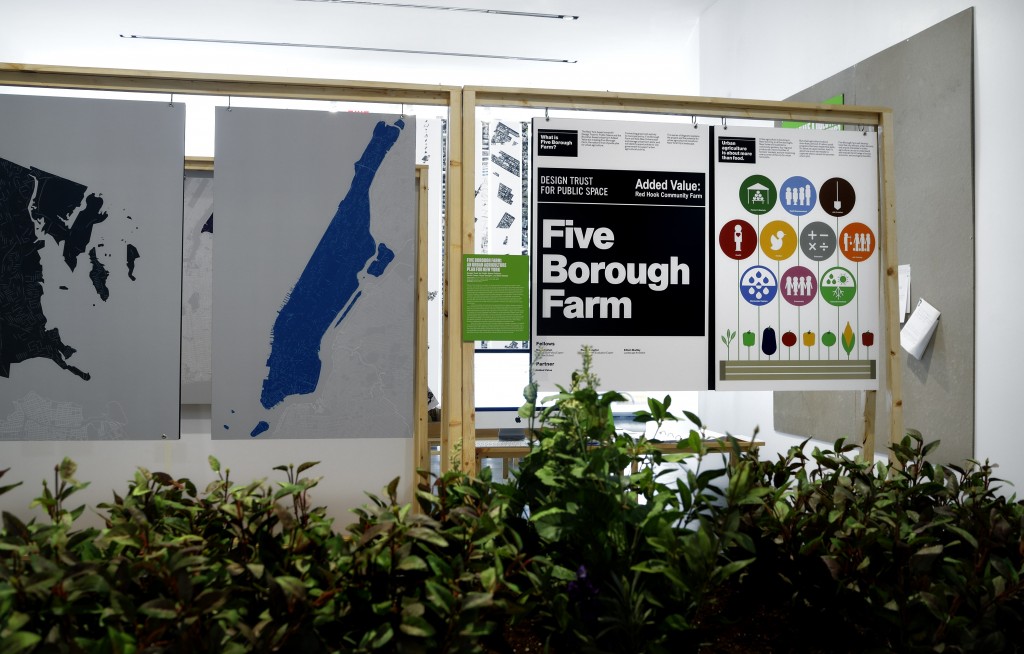Divided into three sections, Public Programming, Carrot City, and Living Concrete, the exhibit prompts movement. Professor Subramaniam explains that the installation design was inspired by crop rows and grocery store aisles, and visitors might be reminded of other food-related spaces as they maneuver through Living Concrete/Carrot City. The exhibition furniture that fills the gallery was constructed to convey a workman-like feel to the show. Seating for public programs is reminiscent of park benches or crates, and any concerns for visitors’ comfort were assuaged when the first evening program, “Food, Design, and Social Change,” attracted over sixty visitors from both within and beyond The New School, all who sat comfortably engrossed during the two-hour panel discussion.
Public Programming is vital to Living Concrete/Carrot City. As Professor Subramaniam says, “the project’s essential goal is to stimulate dialogue.” With bold, graphic signage facing 13th Street, all of New York City is welcomed in. Public Programs invite all to join in the conversation about urban agriculture every Wednesday from 6:30-8:30pm and every Thursday from 12-1:30pm. Thursday brown bag talks have been created in collaboration with The New School’s Food Studies program. Some presentations feature former Food Studies students, who will share stories of what they’ve accomplished and encountered since graduating.
As Professor Subramaniam and I walk through the gallery, she explains that one of the great underlying goals of the exhibit is to connect individual action to social systems, to bring about community change. When we approach the rainwater collection system, presented as part of Carrot City, she notes a simple example. The installation of a rainwater harvesting system might require some intrusion into another person’s space – enough that one would want to discuss the project with neighbors in an apartment building. This communication alone has potential to raise awareness, and to open the community of the apartment building to new systems previously unknown or unexplored.
As we move through Living Concrete, she points out that some projects on display are works in progress. Five Borough Farm includes an interactive component in which visitors are encouraged to ask questions about anything from compost sites to which seasons are best for which foods to grow. New School students are researching and answering these questions. The Urban Agriculture Mapping Project is an evolving document that changes each week as students mark various sites that promote urban agriculture, such as community gardens, farms, and compost sites. Nevin Cohen’s “Planning Sustainable Cities” class is responsible for this mapping project, and the class meets weekly in the gallery. These works in progress invite visitors to come back to the exhibit again and again to trace their motions forward, and show that Living Concrete/Carrot City is, in fact, part of an ever-changing conversation in a constantly transforming city.
In fact, Professor Subramaniam says that the exhibit itself is meant as a vast conversation between a range of people from farmers to advocates, all who have something to say about food. It is meant as a “social sculpture,” and the exhibit does not claim to define exemplary cases or proclaim correct answers. Rather, it is modeled to promote the belief that individual action always forms part of a larger social network and can bring about great community change. Living Concrete/Carrot City looks to become part of this large and vital conversation, to invite thought, and “to create a hospitable place for such a social dialogue to exist.”
-Rebecca Nison






























